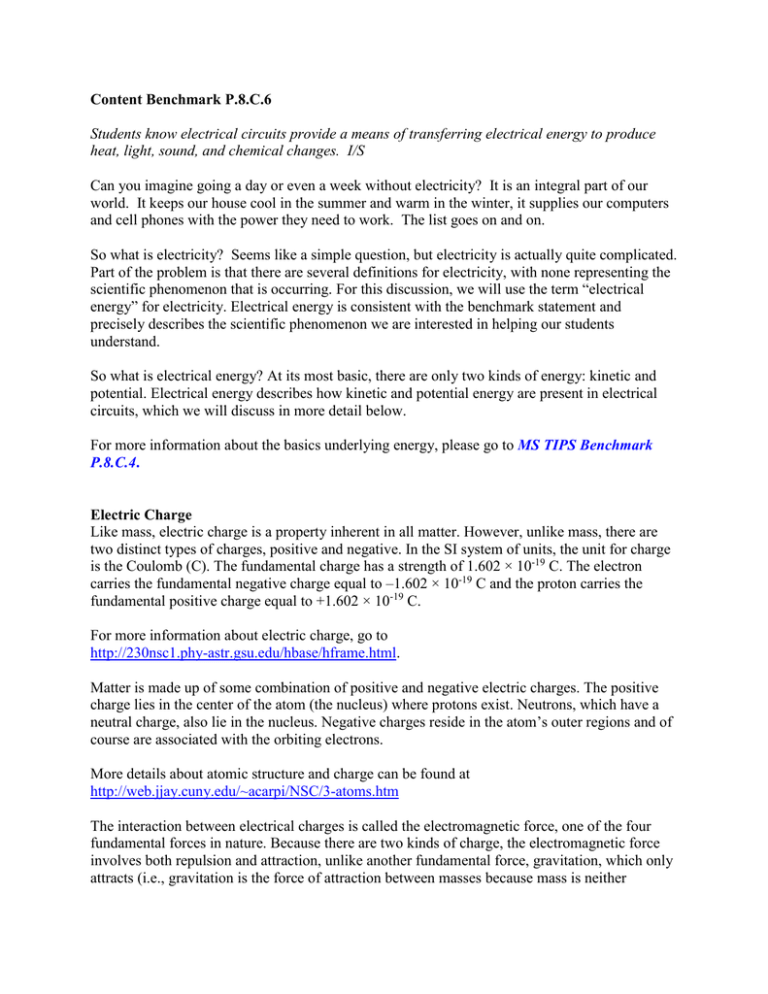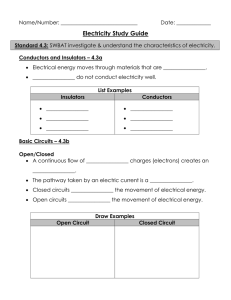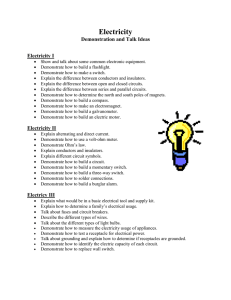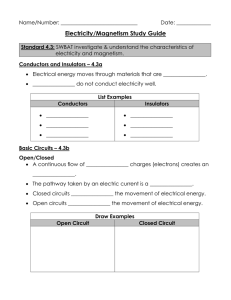Content Benchmark P.8.C.6 heat, light, sound, and chemical changes. I/S
advertisement

Content Benchmark P.8.C.6 Students know electrical circuits provide a means of transferring electrical energy to produce heat, light, sound, and chemical changes. I/S Can you imagine going a day or even a week without electricity? It is an integral part of our world. It keeps our house cool in the summer and warm in the winter, it supplies our computers and cell phones with the power they need to work. The list goes on and on. So what is electricity? Seems like a simple question, but electricity is actually quite complicated. Part of the problem is that there are several definitions for electricity, with none representing the scientific phenomenon that is occurring. For this discussion, we will use the term “electrical energy” for electricity. Electrical energy is consistent with the benchmark statement and precisely describes the scientific phenomenon we are interested in helping our students understand. So what is electrical energy? At its most basic, there are only two kinds of energy: kinetic and potential. Electrical energy describes how kinetic and potential energy are present in electrical circuits, which we will discuss in more detail below. For more information about the basics underlying energy, please go to MS TIPS Benchmark P.8.C.4. Electric Charge Like mass, electric charge is a property inherent in all matter. However, unlike mass, there are two distinct types of charges, positive and negative. In the SI system of units, the unit for charge is the Coulomb (C). The fundamental charge has a strength of 1.602 × 10-19 C. The electron carries the fundamental negative charge equal to –1.602 × 10-19 C and the proton carries the fundamental positive charge equal to +1.602 × 10-19 C. For more information about electric charge, go to http://230nsc1.phy-astr.gsu.edu/hbase/hframe.html. Matter is made up of some combination of positive and negative electric charges. The positive charge lies in the center of the atom (the nucleus) where protons exist. Neutrons, which have a neutral charge, also lie in the nucleus. Negative charges reside in the atom’s outer regions and of course are associated with the orbiting electrons. More details about atomic structure and charge can be found at http://web.jjay.cuny.edu/~acarpi/NSC/3-atoms.htm The interaction between electrical charges is called the electromagnetic force, one of the four fundamental forces in nature. Because there are two kinds of charge, the electromagnetic force involves both repulsion and attraction, unlike another fundamental force, gravitation, which only attracts (i.e., gravitation is the force of attraction between masses because mass is neither positive nor negative). A simple rule guides the rule of electrical force and charge: like charges repel and opposite charges attract, and the strength of the force is proportional to the strength of the overall positive and/or negative charge on objects. The attraction and repulsion of electrical charges are shown schematically in Figure 1. Figure 1. Diagram of charges attracting and repelling (From http://www.sciencemadesimple.com/static.html) To find out more about the electrical force, go to http://www.colorado.edu/physics/2000/waves_particles/wavpart2.html Static and Current Electricity Both current and static electricity are the transfer of energy through moving electric charges. Static electricity is what causes lightening and the small shocks felt from a door knob or a person. Current electricity is what lights our houses and causes our appliances and electronics to work. Static electricity involves separation of electric charges outside of closed circuit. For example, as you rub your socks along carpet, charges are separated on your socks. As the charges separate, the electric force between them increases. Then when you touch another object, like a person, those charges discharge through that touch. Figure 2. Negatively Charged Balloons (From http://www.lewisporteacademy.com/elecweb/topone.html) For more information about static electricity, go to http://science.howstuffworks.com/vdg1.htm Current electricity is the movement of electric charges in a closed circuit. For example, when a battery is hooked up to wire and an electric motor, the transfer of energy through the circuit causes the motor to spin. We will discuss current electricity in more detail in the next sections. Parallel and Series Circuits Electric circuits can have many different parts, but they all need certain items. An energy source is needed to make the circuit work. This is usually a battery or an outlet. Conductors, usually wires, are also needed to connect the circuit together. Finally, a circuit needs a load, which is the object it is powering. It can be a motor, a light bulb, a buzzer, or any other item that needs electrical energy to work. Circuits can also contain switches to turn the circuit on and off, and resistors which can represent any item that slows the electric current down. To learn more about the parts of an electrical circuit, go to http://www.glenbrook.k12.il.us/GBSSCI/PHYS/CLASS/circuits/u9l2b.html In all circuits, the electrical energy must be transferred through a complete conduction loop. In other words, the energy must be transferred from the energy source, through the conductors and loads, and back to the energy source. There two basic types of circuits: series and parallel. A series circuit has only one path for the electric current to flow. Figure 3. A series circuit is represented using pictures. (From http://media.allrefer.com/s1/l/s0281500-series-circuit.jpg) The series circuit shown in Figure 3 has a battery, a switch and three light bulbs. However, a series circuit can have one load or many loads, as long as they are connected “one after the other,” so they create one path for electric current. In a series circuit, if one light or load stops working, everything in the circuit stops working because there is no longer a closed loop for energy to be transferred. A parallel circuit has two or more paths for electric current to flow. Figure 4. A parallel circuit is represented using pictures. (From http://electronics-for-beginners.com/pages/page/1070/) In Figure 4, the parallel circuit contains one battery and three light bulbs, where each bulb is connected in paths that are all parallel to each other. Within a parallel circuit, when one light stops working, the loads on the other paths continue to work because the broken light does not close all the circuits and energy may be transferred back to the source. Circuits can also use a combination of series and parallel sections within the same circuit. Circuits are often drawn using symbols instead of pictures. Figure 5. In this figure, both a series circuit and parallel circuit are shown using pictures and symbols. (From http://www1.curriculum.edu.au/sciencepd/electricity/images/elec_ill76.gif) This picture shows the drawing of the circuit with both pictures and symbols. There is more than one symbol for each component, depending on how the circuit diagram is used. For additional information about electric symbols, go to http://www.kpsec.freeuk.com/symbol.htm Conductors, Resistors, and Insulators Conductors are materials that allow electric current to flow easily. These are materials whose electrons are not held tightly to the atom. Copper is an example of a good conductor. Insulators are materials that do not let electric current to flow easily. These atoms hold very tightly to their valance electrons. Plastic and wood are examples of good insulators. To learn more about electrical conductors and insulators, go to http://www.glenbrook.k12.il.us/gbssci/phys/Class/estatics/u8l1d.html. Resistors are items that limit the flow of electric current to a specific amount. Although an electrical load, such as a light bulb or electric motor, resist current flow, a resistor is designed to keep the current in a part of the circuit at a specific amount. A classic resistor has no other function. The amount of resistance depends on length, thickness, material, and temperature of the device. High resistance severely limits the flow of electric current and low resistance provides little limit to the flow of electric current. More information about resistors can be found at http://www.newton.dep.anl.gov/askasci/comp99/CS049.htm. Electrical Energy Transfers Electrical energy is transferred through circuits in a way that allows that energy to be transformed into something useful. This typically happens in an electrical load. For example, an electrical motor is an example of a common load found in a circuit. In this case of the motor, electrical energy is transferred to kinetic energy to turn such things as fans that cool computers and blow dry our hair, winches that raise elevators, and DVD drives that play movies. More details about electrical motors can be found at http://www.howstuffworks.com/motor.htm Figure 6. Energy transfers with an electric lamp. (From http://www.bbc.co.uk/schools/gcsebitesize/science/aqa/energy/heatrev5.shtml) In addition, many types of energy can be transferred into electrical energy as well. For example, light energy from the sun can be collected by photovoltaic cells which can be transferred into electrical energy to heat homes and pools. Figure 7. Electrical energy from a dam. (From http://www.bbc.co.uk/schools/ks3bitesize/science/physics/energy_transfer_6.shtml) For more information about how electrical energy is generated, go to HS TIPS Benchmark P.12.C.6. Content Benchmark P.8.C.6 Students know electrical circuits provide a means of transferring electrical energy to produce heat, light, sound, and chemical changes. I/S Common misconceptions associated with this benchmark 1. Students inaccurately assume that parallel circuits have 2 lights and two paths and series circuits have one path and two lights only. Often times the examples in the textbooks, on worksheets, and online only have two lights on the diagrams and only show parallel circuits with 2 paths. Actually, parallel circuits are any circuits that have more than one path and series circuits are circuits that have one path. The number of light bulbs or loads on the circuit does not dictate whether or not the circuit is parallel or series. For more information on series versus parallel circuits, go to http://www.allaboutcircuits.com/vol_1/chpt_5/1.html 2. Students inaccurately assume all metals and shiny objects are good conductors of electricity. Not all metals conduct electricity well. Although most metals can conduct some electricity, they do not all do it as easily as copper. In addition, shininess does not mean that the object conducts electricity. For example, even though glass is shiny, it does not conduct electricity. For more information on conductors, go to http://www.ndt-ed.org/EducationResources/HighSchool/Electricity/conductorsinsulators.htm 3. Students have difficulty understanding that friction is not what creates static electricity. Static electricity is the separation and buildup of electrical charge. Frictional forces often separate charges, particularly if a certain material allows charges to be separated relatively easily with normal frictional forces (e.g., rubbing your feet across a carpeted floor). However, the friction does not create the static electricity; it merely is the force that helps separate charge and increases the electrical forces between objects. To learn more about static electricity, go to http://www.sciencemadesimple.com/static.html 4. Students incorrectly believe that batteries and generators create electric charge and the charge becomes used up as it flows through a circuit. Energy cannot be created nor destroyed. Batteries contain reactive chemicals inside that react to transform potential chemical energy into electrical energy. Generators use a variety of different sources including magnetic energy and steam for transferring into electrical energy. To learn more about this and other misconceptions associated with electricity, go to http://amasci.com/miscon/eleca.html#batt Content Benchmark P.8.C.6 Students know electrical circuits provide a means of transferring electrical energy to produce heat, light, sound, and chemical changes. I/S Sample Test Questions Questions and Answers to be inserted from a separate document Content Benchmark P.8.C.6 Students know electrical circuits provide a means of transferring electrical energy to produce heat, light, sound, and chemical changes. I/S Answers to Sample Test Questions Questions and Answers to be inserted from a separate document Content Benchmark P.8.C.6 Students know electrical circuits provide a means of transferring electrical energy to produce heat, light, sound, and chemical changes. I/S Intervention Strategies and Resources The following is a list of intervention strategies and resources that will facilitate student understanding of this benchmark. 1. Online Electrical Energy Demonstrations The University of Colorado’s Physics Education Technology site has several interactive Java applets that show fundamental physical science principles. In particular, the site has some really interesting interactives that demonstrate several concepts about electrical energy. This site could be projected onto a screen to discuss with the whole class, or if an online computer lab is available, students could conduct their own demonstrations about electrical energy. The site requires that all computers have a current version of Java running. To access all the demonstrations about electrical energy, go to http://phet.colorado.edu/simulations/index.php?cat=Electricity_Magnets_and_Circuits A specific demonstration about static electricity is found at http://phet.colorado.edu/simulations/sims.php?sim=Balloons_and_Static_Electricity As well as one about electrical resistance at http://phet.colorado.edu/simulations/sims.php?sim=BatteryResistor_Circuit 2. Static Electricity Lessons The American Association for the Advancement of Science, which created the Benchmarks for Science Literacy, has developed a series of lessons that reinforce student understanding of static electricity. The lessons are designed to deepen student understanding of positive and negative charge and how charges are separated in static electricity situations. The lessons require that students have Internet access. To access the first lesson, which also has links to the lessons 2-4, go to http://www.sciencenetlinks.com/lessons.cfm?Grade=6-8&BenchmarkID=4&DocID=234 3. Experiments with Electrical Energy The Institute of Electrical and Electronics Engineers, Inc. (IEEE) has a large educatorfriendly website that contains several experiments involving electrical energy. Information about these experiments, along with handouts, is available for printing in PDF format, and also available in Spanish language. To get their lesson on insulators and conductors, go to http://www.ieee.org/web/education/preuniversity/tispt/linscond.html. To download their lesson focusing on solid conductors, go to http://www.ieee.org/web/education/preuniversity/tispt/lsolidcond.html. An experiment involving series and parallel circuits, is found at http://www.ieee.org/web/education/preuniversity/tispt/lseriespar.html. Students can build a working electrical motor, by accessing the lesson at http://www.ieee.org/web/education/preuniversity/tispt/lmotors.html. 4. Lightning! The Nova program on PBS has several effective programs and associated lesson plans, including one that explores lightning and static electricity. The following activity is a great one for students to see how charges are separated to form “lightning-like” zaps that are both a little shocking and fun. A PBS video can accompany the program, but is not necessary to conduct the activity. To find out more about the lightning activity, go to http://www.pbs.org/wgbh/nova/teachers/activities/2213_lightnin.html. 5. Hydrogen Fuel Cells Nova’s Science Now program has created a great interactive website that discusses the use of hydrogen fuel cells for automobiles. Hydrogen fuel cells operate by separating electrical charge and using the associated electrical energy to drive the car’s engine. The video that accompanies the site is relatively short (14 minutes) and can be downloaded from the Internet. The site also includes several interactive activities, but Internet access and a computer lab are required. To view the site and the associated teacher’s guide, go to http://www.pbs.org/wgbh/nova/sciencenow/3210/01.html





